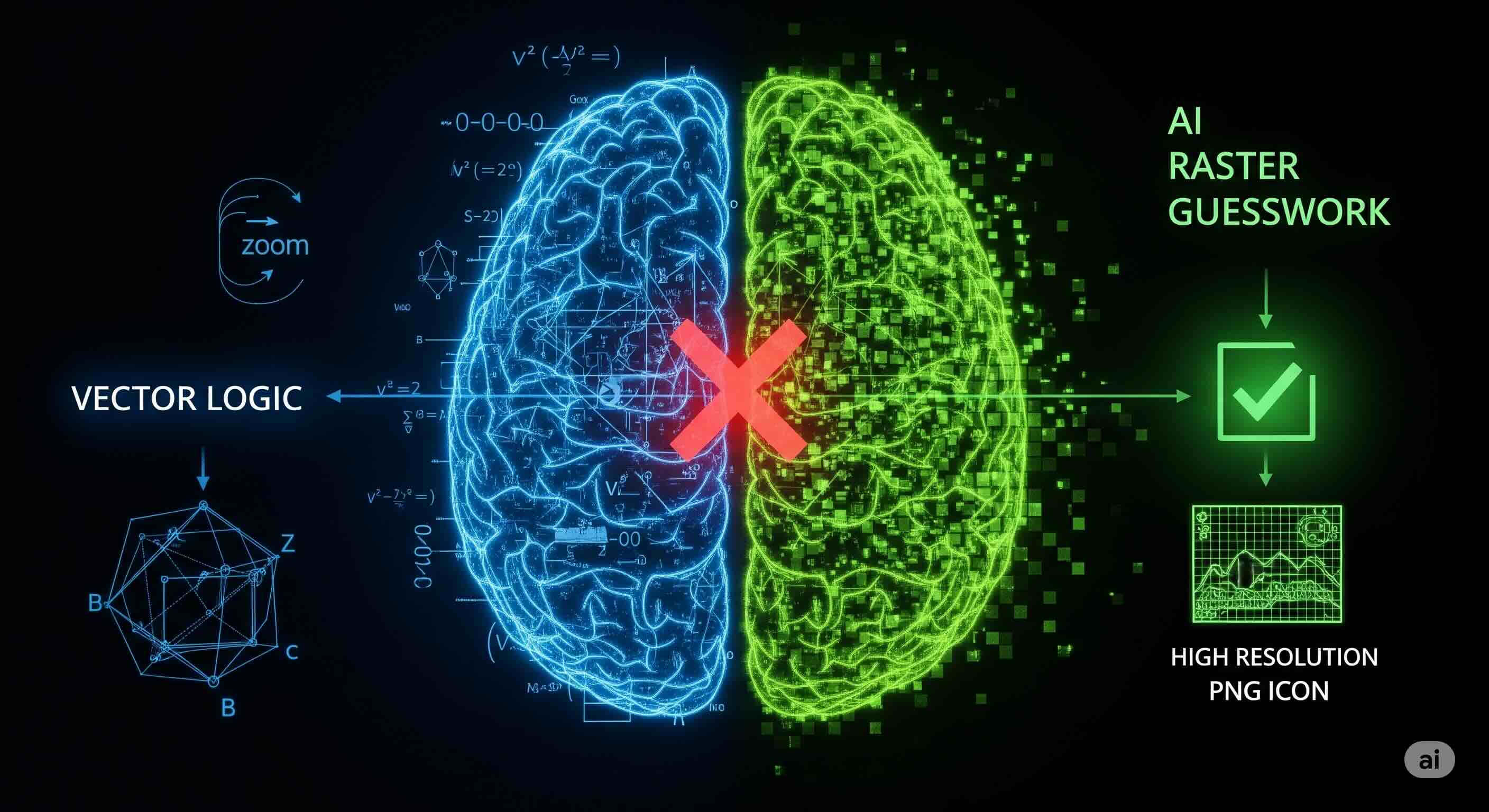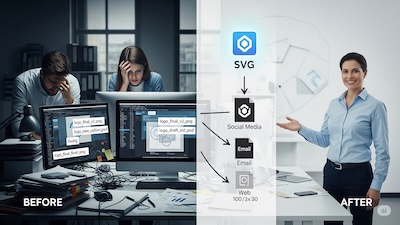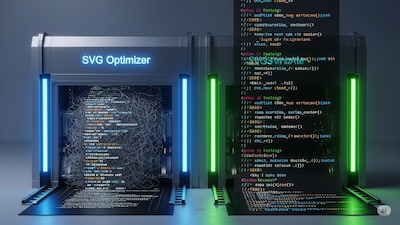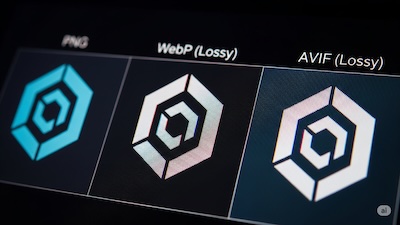AI Upscaling SVGs: Should You Do It Before Converting to PNG?
 iSVGtoPNG Team
iSVGtoPNG Team

I was on a consulting call recently when a sharp young developer asked a question that made me pause: "What's the best AI upscaler to use on our SVGs before we convert them to PNGs for the website?" The question was thoughtful, proactive, and born from a genuine desire to improve quality. It was also based on a fundamental misunderstanding of the technologies involved.
As a web performance veteran who has optimized millions of images over the last 15 years, I see this kind of question more and more. The hype around AI image tools is deafening. They promise to add detail, fix low-resolution photos, and work magic with a single click. And for their intended purpose—improving raster images—they are genuinely revolutionary. But applying that logic to the world of vector graphics is a critical mistake. It's like trying to use a calculator to proofread a novel.
This guide is here to clear the confusion. We're going to tackle this question head-on, not to dismiss it, but to use it as a launchpad to understand the core principles of vector and raster graphics. I will show you precisely why "AI upscaling an SVG" is a redundant and counterproductive concept, and then I'll reveal the correct, simpler, and higher-quality professional workflow to get the flawless PNGs you're actually looking for.
Vector vs. Raster: Why AI Upscaling Doesn't Apply to SVGs
The entire premise of the question falls apart once you understand the philosophical difference between an SVG file and the images that AI upscalers are designed to fix.
What an SVG Truly Is: A Mathematical Blueprint
An SVG (Scalable Vector Graphic) is not an image in the traditional sense. It is a set of instructions. It's an XML-based text file that says, "Draw a perfect circle here with a radius of 30px." You can open an SVG in a text editor or an SVG Viewer and see this code for yourself. Think of it as an architectural blueprint. The blueprint for a skyscraper doesn't have a "size." It's a set of precise instructions that can be used to build a small model or the full-sized building. An SVG is the same; it is infinitely scalable by nature. Its quality is perfect whether you render it at 16x16 pixels or 1600x1600 pixels.
What AI Upscaling Actually Does: Intelligent Guesswork for Pixels
AI upscaling, on the other hand, was invented to solve a problem in the *raster* world. A raster image (like a PNG, JPEG, or GIF) is a fixed grid of colored squares, or pixels. If you have a 100x100 pixel photo and you try to stretch it to 200x200 pixels, the computer has to invent 30,000 new pixels. AI upscalers are a brilliant solution to this. They use a trained machine learning model to analyze the existing pixels and make intelligent guesses about what the missing pixels *should* be.
The Collision: The Flawed AI Upscaling Workflow
Now, can you see the conflict? Trying to "AI upscale an SVG" is a logical fallacy. To do it, you would have to:
- First, convert the perfect SVG blueprint to a low-resolution PNG (throwing away the infinite detail).
- Then, feed that low-resolution PNG into an AI upscaler to guess its way back to a high-resolution PNG.
You've introduced two extra steps and a layer of guesswork, all to end up with a result that is guaranteed to be inferior to doing it the right way.
The Real Problem: Why Your PNGs Look Bad (It's Not Scale)
If you've found yourself asking this question, it's because you're experiencing a real problem: your PNGs converted from SVGs look bad. The instinct to reach for an AI tool is understandable, but the diagnosis is wrong. The problem isn't the "scale" of your SVG; it's the quality of your conversion workflow.
- Culprit #1: You're Rendering at the Wrong Size. You're serving a 1x PNG to a 2x high-DPI screen, causing blurriness. We cover the solution in our guide to automating @2x/@3x exports.
- Culprit #2: Your Conversion Process is Low-Quality. Many simple online tools use fast, low-quality renderers that cause the jagged edges and logo fails.
- Culprit #3: Your Source SVG is Contaminated. Your SVG might contain "junk code" or embedded low-resolution bitmaps. It's critical to clean and optimize your SVGs before conversion.
The Professional Workflow: Render, Don't Upscale
The correct workflow is simpler, faster, and produces mathematically perfect results. It bypasses AI entirely and leverages the native power of vector graphics. The goal is not to "upscale" the SVG, but to **render the SVG at the final target resolution.**
| Workflow Step | The Flawed "AI Upscaling" Method | The Correct Professional Method |
|---|---|---|
| 1. Source File | Start with a master SVG. | Start with a master SVG, then clean it with an SVG optimizer. |
| 2. Conversion | Convert SVG to a low-res (1x) PNG. | Use a high-fidelity SVG to PNG converter to render the SVG directly to the final high-res size (e.g., 400px). |
| 3. "Enhancement" | Feed the low-res PNG into an AI upscaler to guess its way to a high-res PNG. | (This step is not needed). |
| 4. Optimization | Compress the AI-generated PNG. | Run the perfectly rendered PNG through a PNG compressor for performance. |
| Result | An approximated, imperfect image based on AI guesswork. | A mathematically perfect, pixel-sharp image. |
Using a batch converter can automate the correct professional workflow for hundreds of icons in a single operation.
Conclusion: Trust the Math, Not the Magic
The allure of AI is strong, but for this specific task, it's a solution in search of a problem. The "magic" you're looking for is already built into the very nature of SVG technology. Its infinite scalability is its superpower.
Don't complicate your workflow by trying to "upscale" a vector. Instead, embrace the correct, professional process: start with a clean SVG source and use a high-quality converter to render it directly to the exact pixel dimensions you need. This method is not only simpler and more efficient, but it also yields a mathematically perfect result that no AI guesswork can ever truly replicate.

iSVGtoPNG Team
iSVGtoPNG Team is a front-end developer and graphics enthusiast with over 10 years of experience in web technologies. She loves exploring the intersection of design and code.


